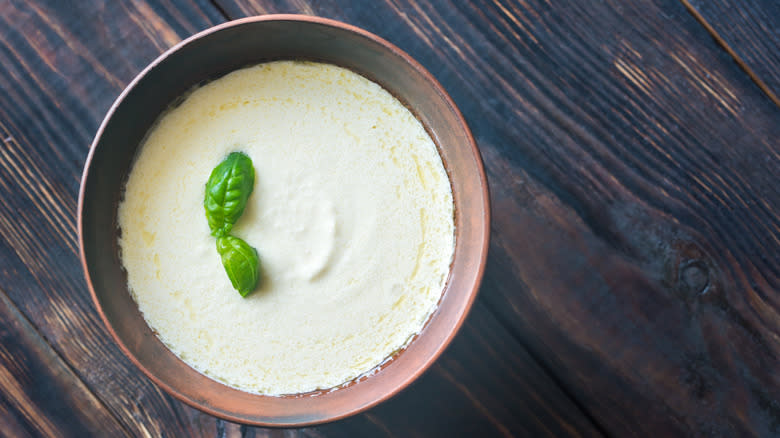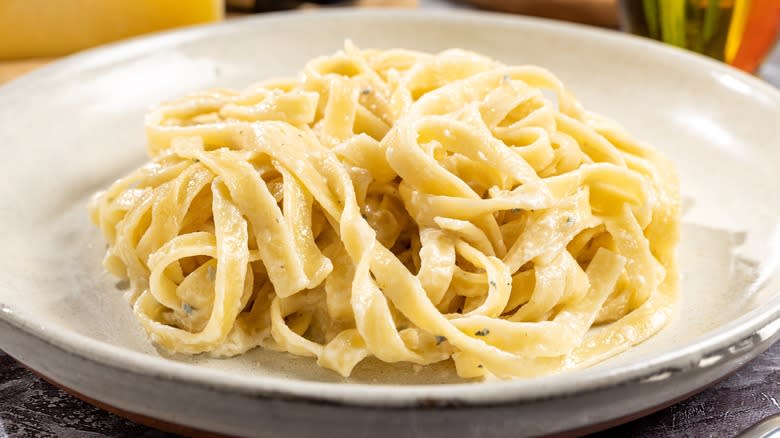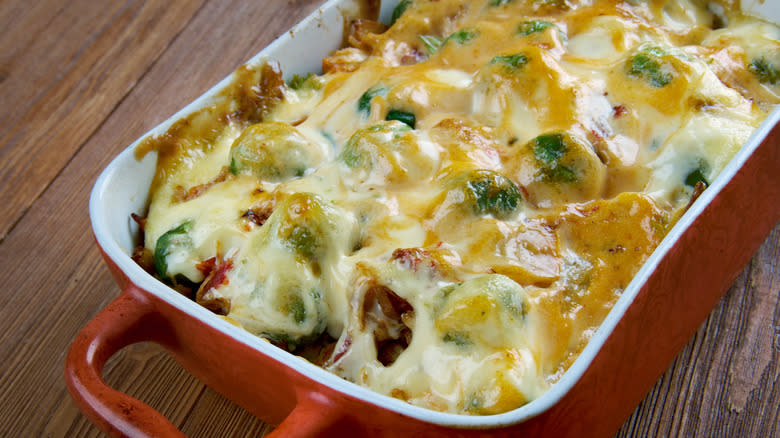Is There A Difference Between Béchamel And Alfredo Sauce?

Whether you're a newer cook or have years of experience in the kitchen, it's easy to get your white sauces mixed up. They all tend to be thick, creamy, and, well, white — which means it's hard to tell from first glance the ingredients that go into each one and the techniques that are used to make them. Plus, with so many types out there (including cream, mornay, and soubise sauce), it can tough to tell where to start with your white sauce education. Let's narrow down the list to two of the most popular types in the U.S.: béchamel and Alfredo.
Not only are they very similar in appearance, but they have a few applications in common, too. You can use them in chicken or pasta dishes, and both are tasty toppings for a plate of roasted vegetables. Plus, béchamel and Alfredo are made over the stove with dairy ingredients and simple flavorings. So what's the difference between these two sauces, and how do you know when to use each? It mostly comes down to the ingredients involved, and how they're made and used.
Read more: 26 Types Of Pasta Sauce Explained
What Is Béchamel Sauce?

Béchamel is considered one of the most basic, yet important, sauces in cooking. Officially, it's one of the five mother sauces designated by French chef Auguste Escoffier (the others being Hollandaise, tomato, Espagnole, and veloute). The ingredients in a béchamel sauce are simple. All you need is butter, flour, milk, salt, and nutmeg. All in all, the whole thing will take about 30 to 40 minutes to make, and you'll only need to deploy simple cooking techniques.
The roots of this mother sauce go all the way back to 1500s France. It's a bit murky as to who specifically invented it, as there are multiple theories. Béchamel originally popped up in France through Catherina de Medici's chefs, who may have gleaned the recipe from Tuscany. Over the years, it's taken on multiple names, including salsa colla in Tuscany, which means glue sauce, and bishemel in 18th-century Britain. However, its modern name comes from Louis de Béchamel, a general to Louis XIV who was alive during the 1600s. Back in the day, the sauce was made with onion skins, root vegetable peels, spring onions, black pepper, and parsley, along with the ingredients that are used today.
What Is Alfredo Sauce?

If you've ever been to an Italian restaurant in the U.S., you've likely seen fettuccine Alfredo on the menu. This dish, typically made with chicken or shrimp, is often considered an Italian-American creation (perhaps thanks to its popularity at chains like Olive Garden), but it was actually invented by an Italian in Rome named Alfredo di Lelio. However, it doesn't have centuries of history behind it, the way béchamel does. It was first dreamed up in 1908, when di Lelio's wife, Ines, was weakened from giving birth to their first son. Looking to feed her something easy on the tummy, he hand-made fettuccine and coated it in a sauce of butter and parmesan cheese. Eventually, Ines encouraged di Lelio to put the dish on the menu of his restaurant, Piazza Rosa.
Today, Alfredo sauce hasn't changed too much. A basic recipe combines butter, heavy cream, and parmesan. However, some recipes call for flavorings like garlic, black pepper, Italian seasoning, parsley, or red pepper flakes. While it has its roots in Rome, this sauce really became popular in the U.S. in the 1900s, with Americans discovering it on their travels and bringing it home.
Béchamel Sauce Requires A Roux

Aside from the ingredients involved, one of the main differences between béchamel and Alfredo sauce comes down to how they're made. A béchamel sauce starts with a white roux, which is simply a combination of the same amounts of flour and fat (in this case, butter). A roux helps to thicken a sauce, which is why béchamel is normally a little denser than Alfredo. To make a white roux, you'll need to melt butter in a skillet, then stir in the flour constantly just until everything has properly combined and the mixture is smooth. Then to build the rest of the béchamel, you'll want to ramp up the heat, stir in the milk, and let everything simmer for up to 20 minutes on medium low before sprinkling in the seasonings.
Making an Alfredo sauce, on the other hand, is more of a straightforward process. You'll start off the same way, by melting butter. But instead of building a roux, you'll simply simmer the butter with your heavy cream, toss in the parmesan and seasonings, and stir constantly until the cheese melts. The parmesan is what will thicken your sauce here, so feel free to add a little more if your mixture is looking thin.
Béchamel Is A Base For Sauces And An Ingredient On Its Own

The fact that béchamel is one of the five mother sauces means it's one of the foundational cooking sauces in today's world. Therefore, it can be used in myriad ways, and many other sauces are built off of the base of a béchamel. A little gruyère or parmesan can turn it into a mornay, which can be used in croque monsieurs or as a Hollandaise substitute. Throw in some sauteed onions, and you have the perfect recipe for a soubise, which can be poured on top of proteins and vegetables. If you want a fishy take on béchamel, add in some crayfish butter and heavy cream to make a Nantua sauce, which you can then use for seafood dishes.
But while béchamel is a versatile base, you don't always have to use it to make another sauce. Its creaminess, thickness, and mild flavors make it an ideal ingredient in mac and cheese (when combined with some grated fromage, of course), casseroles, lasagnas, vegetable bakes, chowders, and chicken or fish pies. Even moussaka, a Greek comfort food, uses the sauce for a creamy layer amid all the meat and veggies.
Don't Be Afraid To Use Alfredo In Creative Ways

If you're willing to depart from the traditional Alfredo recipe, there are plenty of ways you can customize this type of sauce, even beyond your favorite seasonings. To balance out its richness, pour in a drizzle of balsamic, and to create a more robust flavor, add a splash of chicken broth. You can also elevate your recipe with white wine, a pesto swirl, or a spoonful of gochujang. You won't necessarily be creating a new sauce, like you would when building off a béchamel base. But Alfredo's booming popularity in the U.S. means there's plenty of room to get creative.
Beyond pairing it with pasta, chicken, and shrimp, you can dunk your garlic bread (or breadsticks) in it, use it to make a white pizza or lasagna, or sub it in for another white sauce in casseroles, pot pies, and veggie bakes. These days, you don't even have to be a dairy-lover to enjoy Alfredo, as you can use a can of white beans to make a tasty vegan sauce.
Read the original article on Tasting Table.

 Yahoo Lifestyle
Yahoo Lifestyle 
